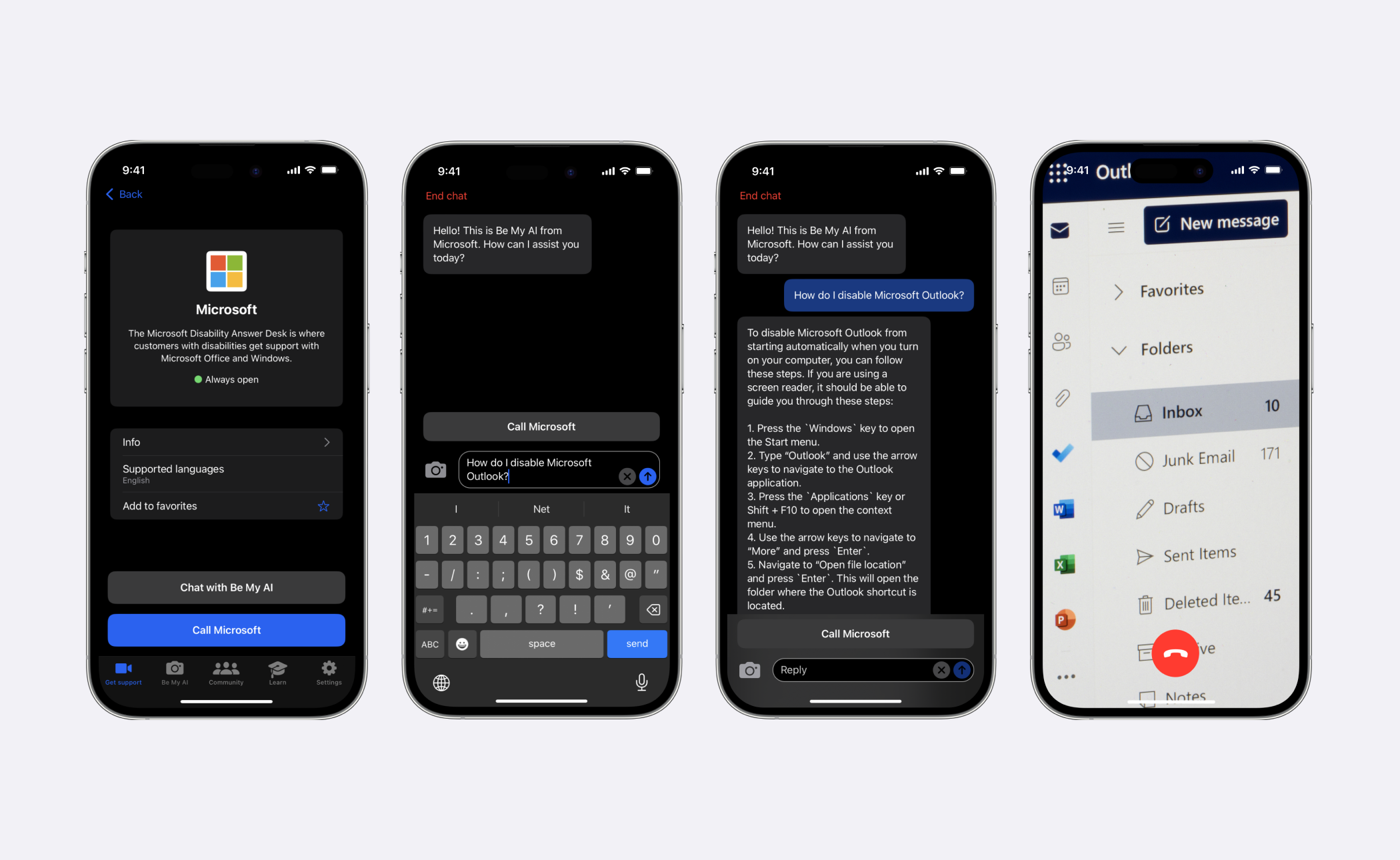
Today Be My Eyes is announcing the successful deployment of Be My AI™, a state of the art visual assistance tool powered by OpenAI’s GPT-4 vision model. Beginning this month, Microsoft Disability Answer Desk callers who are blind or low vision can now use Be My AI™ to handle all types of customer service calls, involving highly complex use cases on everything from Excel spreadsheet formulas and interpreting product instructions and diagrams, to rebooting a laptop or installing and updating software, and much more.
This is the first use of AI accepting image inputs to augment traditional customer service for people with disabilities. In fact, the deployment, which has rolled out globally, is producing stunning early results that meet what Be My Eyes refers to as the 3S Success Criteria™:
“Our new AI-powered accessible customer service model is producing remarkable results for not only one of the world’s largest and most innovative companies, but also for a community of blind and low vision consumers,” said Mike Buckley, CEO of Be My Eyes. “Be My AI™ is the customer service gold standard for companies that want to assist blind and low vision consumers, and we are incredibly thankful to Microsoft for their leadership, willingness to partner on Accessible CX solutions and their help communicating the benefits of Be My AI™ to other enterprises so we can advance our mission to make the world more accessible.”
"OpenAI is proud to work with Be My Eyes. They've used our AI models to significantly enhance the daily lives of people with low vision or blindness," said Brad Lightcap, COO at OpenAI. "Their commitment to making technology more accessible showcases a remarkable blend of empathy and innovation, underscoring the potential of AI when directed by an understanding of community needs. We’re glad to see By My Eyes deploy “Be My AI™” successfully.”
With the new addition of Be My AI™ at the front end of the experience, blind and low vision consumers can receive rapid, automated support for Microsoft-related products and services through AI-based natural language conversations. Be My AI™ can also provide contextual, advice-based guidance on the request at-hand. For example, Be My AI™ can guide you through the steps to install a new version of Windows, describe a PowerPoint presentation, and provide suggestions about the best setup based on your computer’s preferences and hardware. Further, Be My AI™ responses are given in text, so for the first time, customer service is accessible through AI text for people who are Deaf-blind via a refreshable Braille display. And, if Be My AI™ isn’t enough to solve the issue at-hand, calls can still be routed to a live agent from Microsoft’s Disability Answer Desk.
Link to audio-described version
“Microsoft is proud to be the first company to integrate Be My AI™ into our customer service with the Disability Answer Desk. The integration of Be My AI™ creates an innovative, fast and efficient way for disabled customers to receive assistance from Microsoft," said Jenny Lay-Flurrie, Microsoft’s Chief Accessibility Officer. “By combining Microsoft's expertise and the innovative solutions from Be My AI™, we are empowering independence for people with disabilities.”
Thanks to the collaboration between Microsoft and Be My Eyes, users worldwide will now be able to use Be My AI™ to resolve issues specific to Microsoft’s suite of applications, hardware or general questions and inquiries. Up until now, Microsoft offered verbal and visual assistance via agents through their Disability Answer Desk. Now Be My AI™ is a first line of automated support that’s proven to resolve the majority of requests without human assistance in initial beta testing.
This first-of-its-kind integration meets the constantly increasing demand for accessible customer service. The global population of people who are blind or have low vision is approaching 300 million and is predicted to increase dramatically over the next 20 years.
“The large and growing number of blind and low vision people globally, roughly equivalent to the population of the United States, means every company, non-profit, academic institution, and public sector organization has both a moral and business imperative to better serve our community,” said Mark Riccobono, President of the National Federation of the Blind. “The deep commitment of Be My Eyes to have their product development driven by the lived experience of blind people is truly transformative. As a result, Be My AI™ is one of the most exciting technological assistance solutions we have ever evaluated, and given the initial results in the customer service environment, which has historically been a significant source of frustration for blind consumers, we encourage every organization to evaluate this remarkable tool as an important option.”
Microsoft’s Be My AI™-Powered Disability Answer Desk is available 24/7. While blind users of Be My Eyes will always have the option to use traditional human conversations with a Microsoft agent, the addition of an AI option gives users a new and accessible choice many have requested.
With Be My AI™, Microsoft continues to create a more accessible environment for their customers who are blind or have low vision. Microsoft’s implementation of Be My AI™ demonstrates its dedication to providing innovative customer support and paves the way for more efficient and effective support solutions.